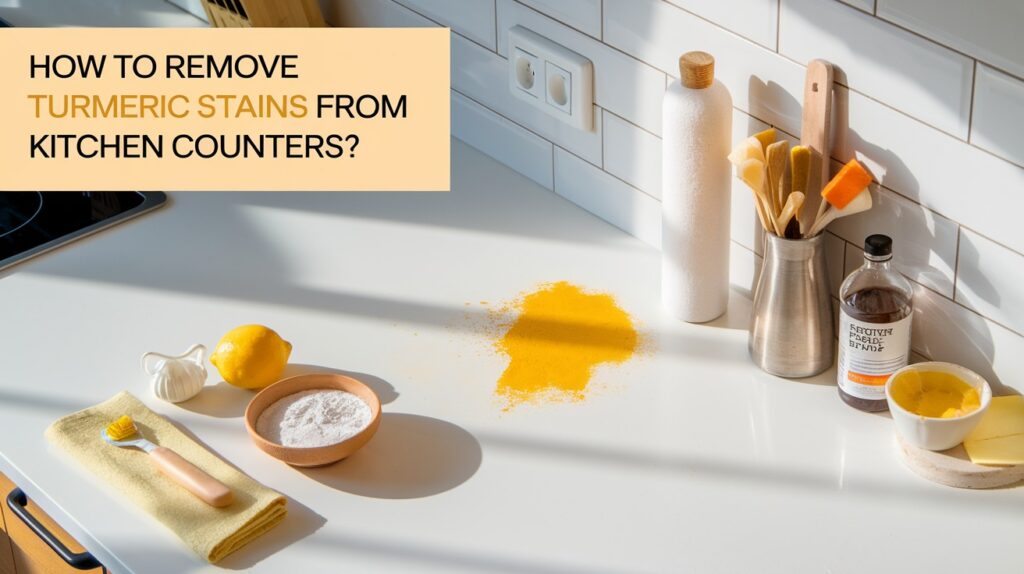I stared at the bright yellow mess on my granite counter last Tuesday morning. One tiny spoon of turmeric had created what looked like a small sun explosion across my kitchen.
You probably know this feeling. That moment when you realize the golden stain isn’t going anywhere with regular cleaning. The panic when you think you’ve ruined your expensive counters forever.
I spent the entire weekend testing different cleaning methods. Some made things worse. Others worked like magic on certain surfaces but failed on others.
This guide shares everything I learned. You’ll find simple steps using items from your kitchen. I’ll help you save your counters without spending money on fancy products.
Why should you trust my advice? I’ve cleaned turmeric off five different counter types and made every possible mistake first.
Why Turmeric Stains Kitchen Counters Easily
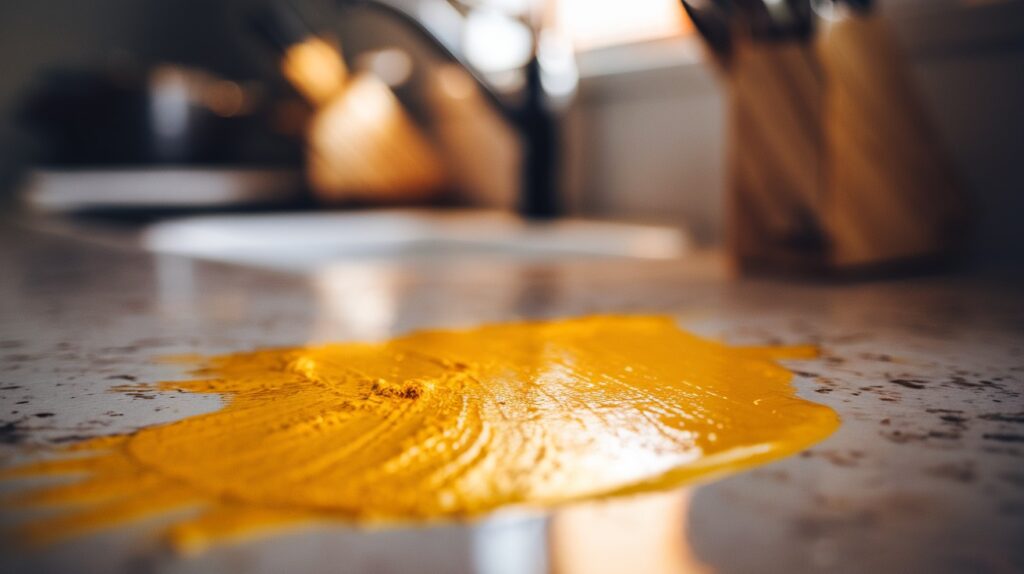
Turmeric contains curcumin. This compound gives the spice its beautiful golden color. It’s also what makes your counter look like a crime scene.
When turmeric hits your surface, curcumin molecules squeeze into tiny pores. They stick like glue. Heat makes this process happen faster.
I learned this lesson while making curry paste. The hot mixture set into my marble so quickly I couldn’t believe it.
This explains why fresh spills clean easier than dried ones. The longer you wait, the deeper those molecules burrow.
Materials You’ll Need
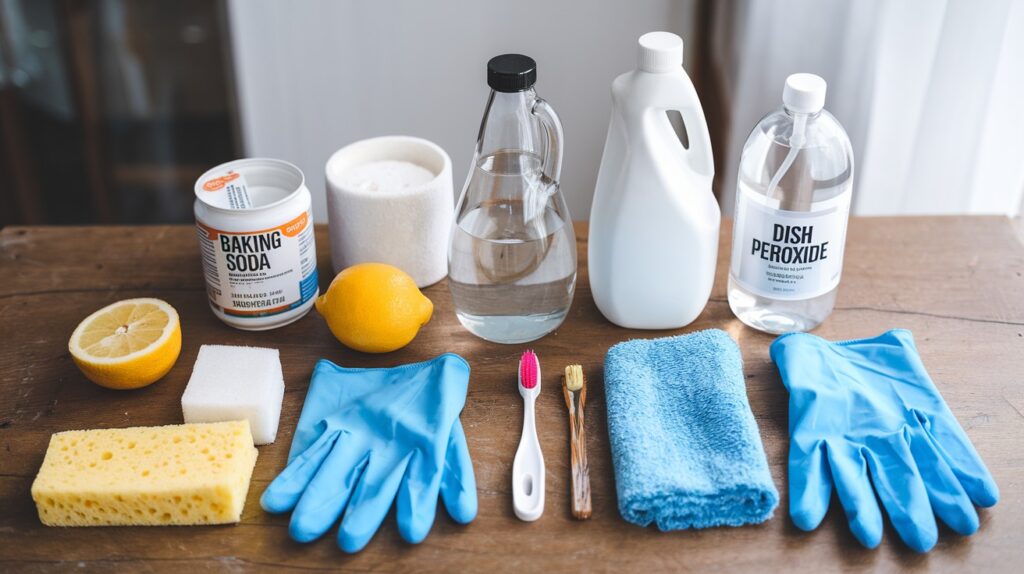
Most of these items are sitting in your kitchen right now.
- Basic supplies: clean cloths, paper towels, dish soap, warm water, and a small bowl.
- Your cleaning weapons: baking soda, white vinegar, fresh lemon, hydrogen peroxide (3% from the drugstore), and cooking oil.
- Helpful extras: old toothbrush, plastic scraper, and rubber gloves.
Don’t panic if something’s missing. I’ll give you alternatives as we go.
How to Remove Turmeric Stains Step by Step
Start with Steps, Work through each step until the stain disappears. Don’t skip ahead even if you’re impatient.
Step 1: Clean Up the Mess Right Away
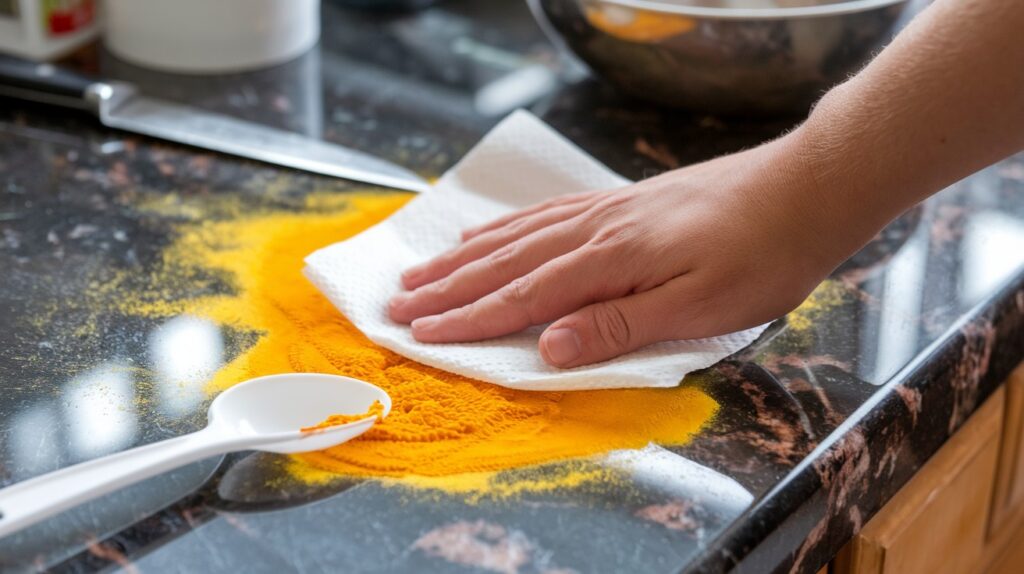
Speed saves your counter here.
If the spill just happened, grab paper towels immediately. Press down firmly and lift straight up. Don’t rub or you’ll spread the stain.
Work from the outside edges toward the center. Keep blotting until your towel comes up clean.
Already dried? Scrape off crusty bits with a plastic spoon. Be gentle so you don’t scratch your counter.
Step 2: Wash with Dish Soap and Warm Water
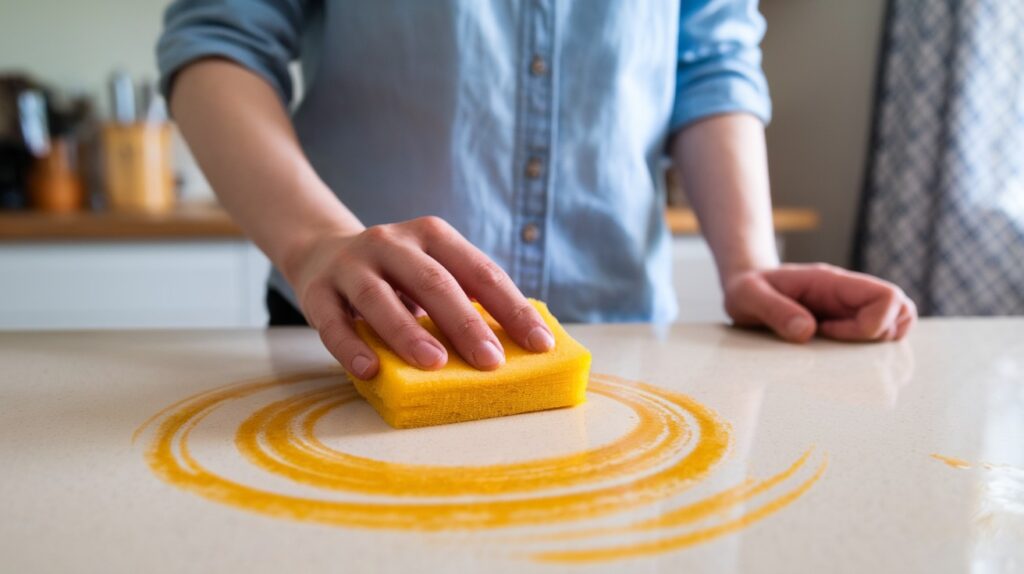
Mix a few drops of dish soap with warm water. Dip your cloth and wring it out well.
Clean the stain using small circular motions. Apply gentle pressure. You’re convincing that curcumin to let go.
Rinse with a fresh damp cloth. Dry everything completely.
Check your progress. If the stain disappeared, celebrate! Still yellow? Keep going.
Step 3: Try Baking Soda Paste
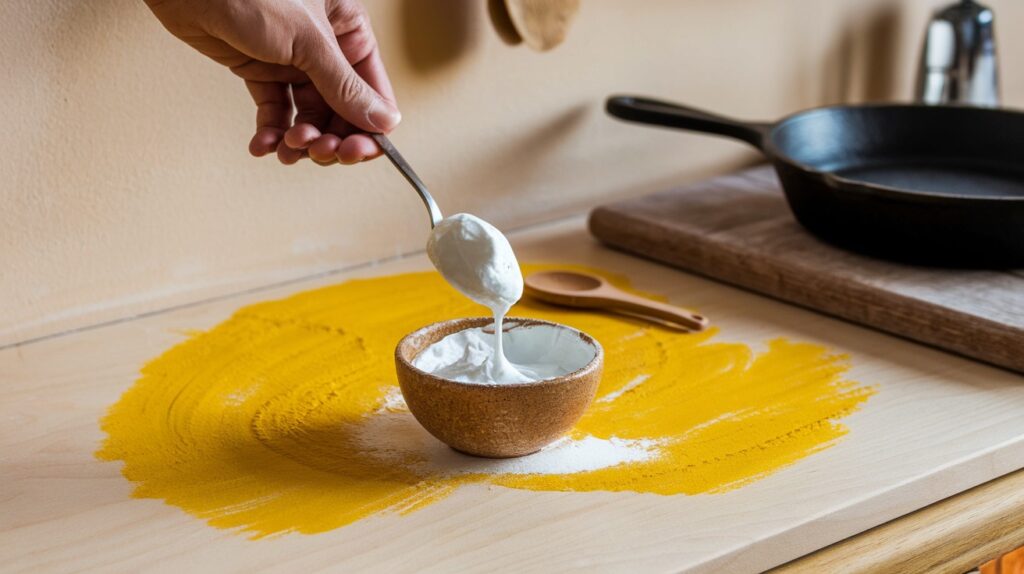
Make a paste with 3 tablespoons baking soda and 1 tablespoon water. It should look like thick toothpaste.
Spread this over the entire stain. Go slightly beyond the edges to catch any hidden stain.
Wait 15 to 20 minutes. I know it feels like forever. Go do something else.
Come back and scrub gently with your cloth. Use circular motions. Rinse thoroughly and dry completely.
Step 4: Use Vinegar or Lemon Juice
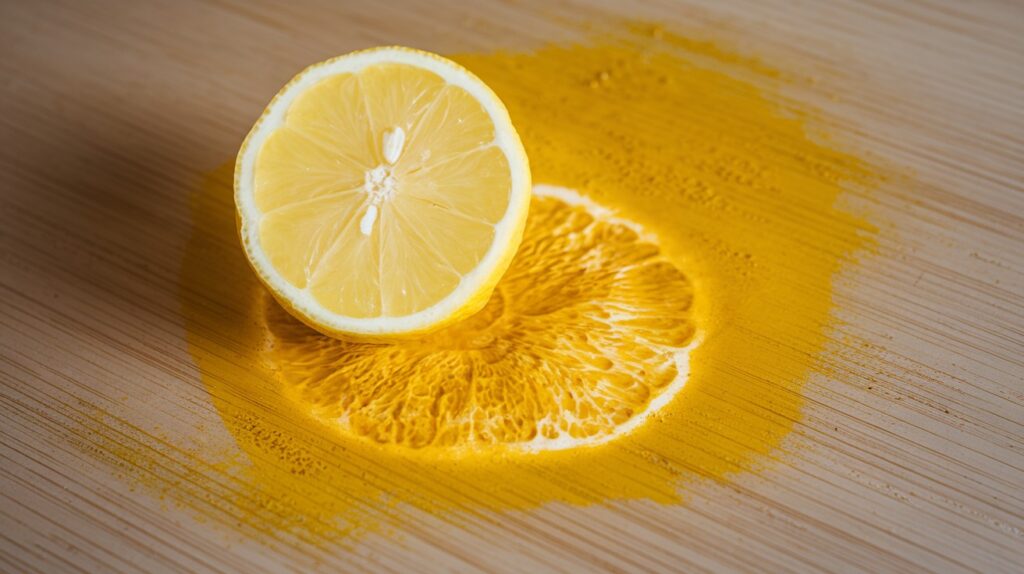
Stop right here if you have marble or granite counters. Acid will damage natural stone permanently. Skip to Step 5 instead.
For other surfaces, spray white vinegar directly on the stain. Watch it bubble. That’s the acid breaking down stain molecules. Wait 5 minutes, scrub, and rinse.
Or cut a lemon in half and rub it on the stain. Let it sit for 10 minutes before scrubbing.
Both methods work well. Use whatever you have handy.
Step 5: Try Hydrogen Peroxide for Stubborn Stains
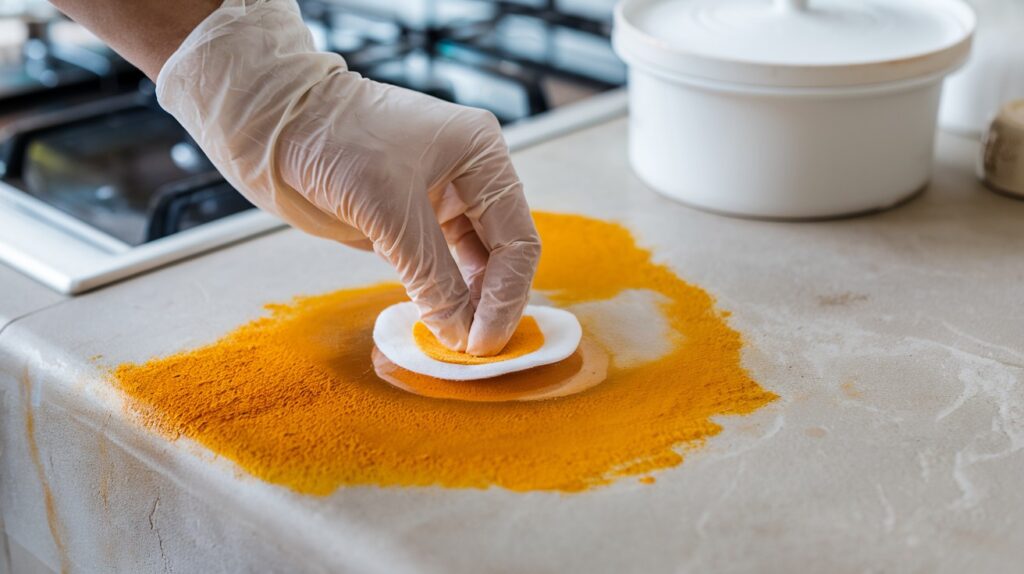
This is your last resort for tough stains.
Put on gloves and open a window. Pour 3% hydrogen peroxide directly onto the stain. Cover with a damp cloth.
Set a timer for 30 minutes. Check every 10 minutes. You should see the stain getting lighter.
Really stubborn? Let it work for up to an hour. Scrub gently with an old toothbrush if needed.
Rinse thoroughly and dry completely. Test this on a hidden spot first. Peroxide can lighten some surfaces.
Different Counter Types Need Different Care
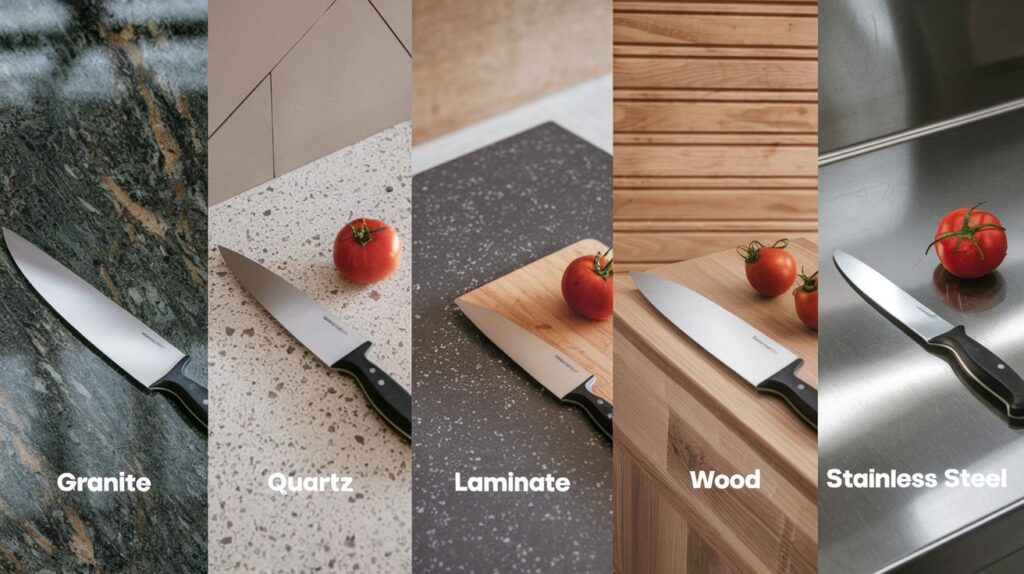
Your counter material affects which methods work safely.
Granite and natural stone never get vinegar or lemon juice. Acid creates permanent damage that costs hundreds to repair. I learned this expensive lesson on a friend’s marble island.
Stick to soap, baking soda, and careful hydrogen peroxide use.
Quartz handles almost anything. You can use every method I mentioned. Just avoid rough scrubbers that dull the shine.
Laminate needs gentle treatment. Use light pressure when scrubbing. Test peroxide on a hidden corner first.
Wood counters need fast work. Too much water warps the boards. For deep stains, try light sanding with fine paper. Sand with the grain direction.
Stainless steel is the easiest. Use any method. Just scrub in the same direction as the grain lines.
How to Prevent Future Turmeric Disasters
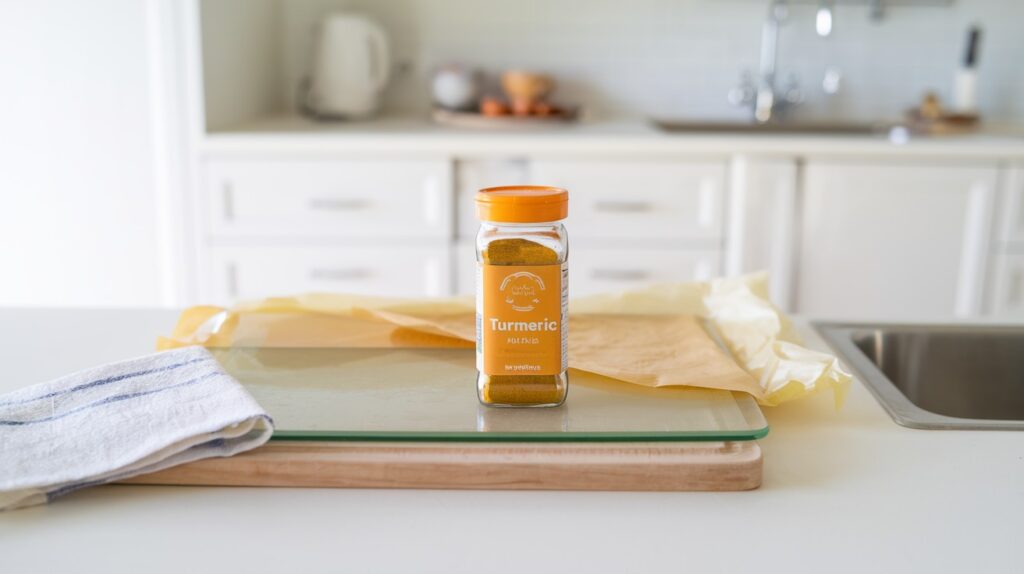
Smart prevention beats perfect cleaning every time.
Place cutting boards everywhere turmeric might land. I use glass ones because they clean easily.
Lay parchment paper under mixing bowls. It sounds silly until you see how much turmeric bounces around.
Keep a damp cloth within arm’s reach while cooking.
Measure turmeric over the sink, not your counter. Use light-colored utensils so you spot stains immediately.
Clean spills while they’re wet. Dried turmeric fights back ten times harder.
Store turmeric in containers with tight lids. Keep cleaning supplies near your spice rack for quick disasters.
Essential Tips
- Act fast – Blot spills immediately with paper towels, don’t rub
- Start simple – Mix dish soap with warm water and scrub in circles
- Try baking soda paste – 3 parts baking soda, 1 part water, let sit 15-20 minutes
- Use acids carefully – White vinegar or lemon juice work, but never on marble/granite
- Go nuclear – Hydrogen peroxide for stubborn stains (test first on hidden area)
- Know your surface – Natural stone needs gentle treatment, quartz handles anything
- Prevent disasters – Use cutting boards and clean spills while they’re wet
- Emergency method – Blot → dish soap → scrub → rinse (under 2 minutes)
- Keep supplies ready – Store cleaning materials near your spice rack for quick response
Conclusion
I remember feeling so relieved when that yellow disaster finally disappeared from my counter. The same victory is waiting for you.
These methods work because I’ve tested them on every surface type. I’ve helped friends save their counters using these exact steps.
Start with the gentlest method first. Work your way up only if needed. Most stains give up after the baking soda treatment.
Remember my golden rule: clean spills immediately. Your future self will thank you when the next accident happens.
Ready to save your counters? Grab your supplies and start with Step 1. Take photos so you can see the change.
Have questions about your specific counter? I love helping people win against stubborn stains. Your kitchen deserves to shine again.
Frequently Asked Questions
Will turmeric stains come back after cleaning?
No, once you remove them properly they stay gone. The stain only returns if you spill turmeric again in the same spot.
Can I use toothpaste to remove turmeric stains?
Whitening toothpaste works on light stains because it contains mild scrubbers. However, baking soda paste works better and won’t leave residue.
Do turmeric stains get worse in sunlight?
Yes, sunlight can set stains deeper and make them darker. Cover stained areas or clean them immediately if your counter gets direct sun.
What’s the worst surface for turmeric stains?
Unsealed natural stone like raw marble absorbs stains fastest. These surfaces need immediate treatment and professional sealing to prevent future problems.
Can old stains from months ago still be removed?
Yes, though they need more effort and multiple treatments. I’ve successfully removed six-month-old stains using hydrogen peroxide with patience.

